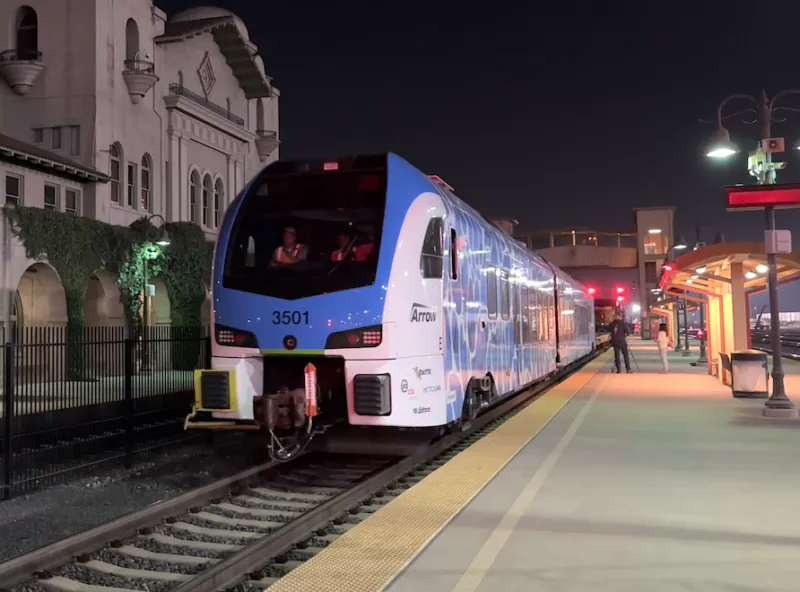Dive Brief:
- Caltrain, the commuter rail line that serves the San Francisco Peninsula, began operating zero-emission electric trains Aug. 11, with fully electrified service between San Francisco and San Jose starting Sept. 21.
- The project to replace diesel-powered trains began in 2016 and required installing overhead catenary wire along 51 miles of the route along with procuring 23 seven-car train sets from Stadler.
- Separately, in Southern California, the San Bernardino County Transportation Authority expects to begin operating self-powered, hydrogen-battery hybrid trains this fall along a nine-mile route between San Bernardino and Redlands, California.
Dive Insight:
Across the U.S., many commuter railroads, such as the Chicago region’s Metra and Southern California’s Metrolink, rely on diesel locomotives to haul their trains. The locomotives emit greenhouse gases along with nitrogen oxides and particulate matter, which are known to cause cancer, cardiopulmonary issues and higher rates of asthma.
According to Caltrain, the transition from diesel to electric trains will cut carbon dioxide emissions by 250,000 metric tons annually. “Caltrain’s Peninsula Corridor Electrification project will not only reduce emissions and air pollution in neighboring communities, but it will also deliver more reliable transportation for commuters in the Bay Area,” said U.S. Sen. Alex Padilla, D-Calif., in a statement.
The $2.7 billion Caltrain project also included upgraded signal systems, installation of positive train control systems and the facilities needed to provide and distribute electricity to the trains. Positive train control systems are designed to prevent train-to-train collisions, excessive speed that could lead to derailments and train movements through incorrectly aligned switches.
The California high-speed rail project to connect San Francisco and Los Angeles, a portion of which is under construction in the state’s Central Valley, will use the Caltrain line from Gilroy, California, to San Francisco.
Caltrain did not electrify its entire route, however. South of the Tamien Station in San Jose, California, Union Pacific Railroad owns the tracks, precluding the installation of overhead wires due to the clearances needed for double-stack container trains. Instead, Caltrain ordered battery-electric, multiple-unit trains from Stadler for use off-wire. In the future, the California High-Speed Rail Authority would like to add electrified tracks within Union Pacific’s freight corridor for its high-speed trains, according to the rail authority’s 2024 business plan.

In Southern California, the San Bernardino County transit agency received its first battery-hydrogen train on June 21. The zero-emission, multiple-unit train will complete testing along the line in preparation for revenue service later this year. The train’s hydrogen fuel cell-battery technology emits only water vapor, a byproduct of the chemical reaction in the fuel cell. The transportation authority’s president, Ray Marquez, called the hydrogen-battery train “transformational” in a statement.
Other transit agencies in the U.S. are moving ahead with battery-electric trains. The Chicago region’s commuter railroad, Metra, ordered eight two-car, battery-powered trainsets from Stadler U.S. this year, with options for eight additional trainsets and up to 32 trailer cars. The Massachusetts Bay Transportation Authority plans to replace diesel-powered trains on its Fairmount Line with battery-electric trains starting in 2028.











